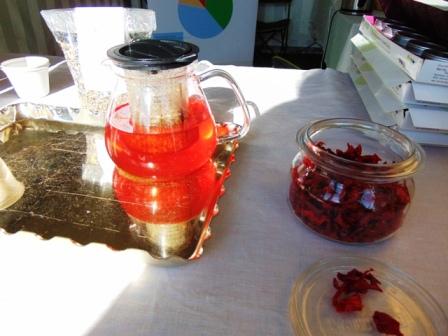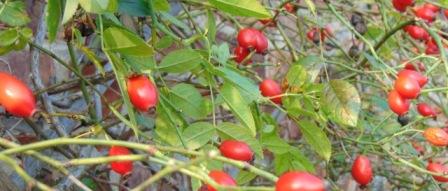An infusion is an aqueous extract of dried or fresh, simple or combined plants (or parts), made by (often hot, 90°C) water (or oil) poured over it. Then this mixture is left, about 7 to 30 minutes in order to dissolve the desired substances in the liquid. The mixture is sieved to drink.
(Infusion is also the term for the dispence of fluids (food, medication, blood) in blood vessels, body cavities or under the skin.)
 Real tea is the hot beverage of the dried leaves of the original Chinese tea plant Camellia sinensis.
Real tea is the hot beverage of the dried leaves of the original Chinese tea plant Camellia sinensis.
Besides theanine and fluoride the existing flavors and fragrances contain ’theine’, another name for caffeine. A cup of tea contains approximately 30 milligrams of caffeine, a cup of coffee on average 75 milligrams.
From 1610 on tea was imported. Since the 17th century the VOC shipped large quantities to the Netherlands.
There are types of black (fermented leaves), green (steamed fermented leaves), white (dried buds), yellow (grilled delicate petals) and others teas.
But also the infusion of herbs and other plant parts is called tea nowadays.
Rooibos is native to South Africa, from the plant Aspalathus linearis.
Other possibilities : balm tansy, bergamot, wild strawberry, blackberry, nettle, lemon balm yarrow, speedwell, raspberry, marigold, ivy, chamomile flower, sorrel, coltsfoot, small fireweed, mullein, lime (fruits), linden blossom, daisy, marjoram, meadowsweet, peppermint, red berries (currant), rose petals, sage, St. John's wort, star anise, thyme, fennel, violets, elderflower, lady's mantle, plantain, licorice.
You pour (boiling) hot water over the plant parts and have them draw (usually less than) 5 minutes.
I also get a nice tea when I clean a 'empty' jam jar with hot water. Quince jelly delivers a fruity, sweet tea. Ditto for a honey jar.
Roses (hip) tea and more
 The rose hip is the fleshy fruit, the swollen, apple -like flower base of a rose.
The rose hip is the fleshy fruit, the swollen, apple -like flower base of a rose.
Raw they taste sour and bitter. There is no other fruit that contains more vitamin C, on average up to 30 times more than oranges!
The hard seeds can be scraped and picked out, or sifted after cooking.
In Chile, coffee is made from the roasted seeds. Cold pressed oil from the seeds would be healing for burns.
The pulp is used for making tea, jam, wine, soup, chutney, sauce, syrup or yogurt etc. They can also be dried (e.g. for tea). Rose petals also are used to make tea and jam.
All rose hips are edible. Tasty dog rose (Rosa canina), the many -flowered rose (Rosa multiflora), the Eglantine (Rosa rubiginosa). The thickest is the Japanese ripple rose (Rosa rugosa).
Thornless Sleeping Beauty
There are no roses without thorns, because they have spines. Although not everyone agrees.
The medieval scholar Albertus Magnus (1200-1280) indicates that distinction as thorns are formed of wood, and spines spring from the surface of the bark. An thorn is a pointed twig, and is connected to the interior of the stem. He is (and breaks) woody. (hawthorn, blackthorn)
A spine, such as blackberry, it is a pointed outgrowth of the epidermis (bark), as a sheet, and is not connected to the interior of the stem or branch. They can have different shapes, colors, sizes... and break off easily.
(There are also roses without thorns spines.)
Salep
The roots of some orchid species contain a nutritious starch -like polysaccharide. Before the advent of coffee and tea the use of salep came from Turkey to Europe. The drink was also used as a medicine and aphrodisiac. (The ancient Romans called the drink e.g. Satyrion and priapiscus!)
Salep is derived from sahlap: ’testicles of a fox.’ ‘Orchis mascula’ means ’male testicle’. Orchid species have two nodules at the end of the roots. A nodule with a light color that is beautiful spherical and is called ’daughter'. That's the good one (iyisi). The other nodule is brown and shriveled and is not used. The best salep grows in poor areas, high in the mountains. Of the approximately 150 species of orchids in Turkey there are 120 suitable to make a fine white salep powder.
The tubers are washed and cooked in whole milk, ayran (a cold yogurt beverage mixed with salt (and water)) or water. After rinsing with cold water they are dried in the sun to about 75 percent of their weight.
The salep powder is used in hot drinks (with water or (goat) milk) and desserts.
The special, very known Turkish ice or dondurma gets by salep a typically solid and sticky texture. (The drink itself is called salep too.)
In the 17th and 18th century in England saloop was also made of local orchid tubers, known as dogstones.
Said the coffee,’I’m hot.’Replies the tea:’Had said earlier. I've been pulling for 5 minutes here.’
